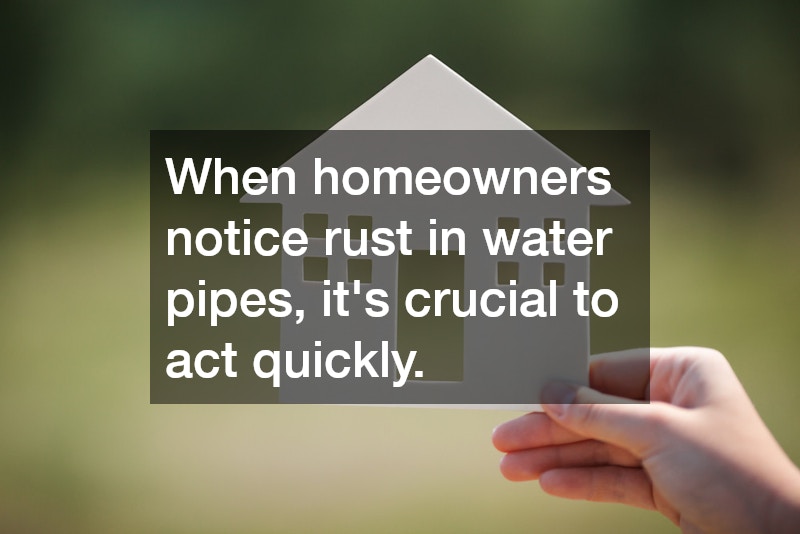Our website may receive compensation from partner links and videos placed in our content.
We are not experts in any particular field. Our content is written by those interested in the various topics, not by professionals. All content is intended to be informational and should not take the place of professional advice. Before making any decisions that could be life altering, please consult with a professional in the field.
A plumbing contractor specializes in installing, repairing, and maintaining plumbing systems for homes and businesses. Whether dealing with new installations or emergency repairs, hiring a licensed contractor ensures your plumbing is safe, efficient, and up to code.
One common issue contractors handle is pipe corrosion repair, which occurs when pipes deteriorate over time due to chemical reactions between water and metal. If left unchecked, corrosion can cause leaks, water discoloration, and even pipe failure.
Rusty pipes are a visible sign of corrosion, typically seen in older plumbing systems made from galvanized steel or iron. Rust weakens the pipe structure, increasing the risk of leaks and contamination. Addressing this issue early helps avoid more extensive and costly repairs.
Corrosion on water pipes not only affects the integrity of the plumbing but can also impact water quality. Corroded pipes release metals like iron or lead into the water supply, leading to unpleasant tastes, odors, and potential health risks.
When homeowners notice rust in water pipes, it’s crucial to act quickly. A plumbing contractor can assess the damage and recommend solutions, such as pipe replacement, relining, or adding water treatment systems to prevent future corrosion. Regular inspections also help maintain a healthy, reliable plumbing system.

Owning a beachfront house is a fantasy of many water lovers. Approximately 36% of vacation buyers purchased beach area property. The crashing waves, surf, and sun can sweep you away. However, you may find yourself stuck in the sand with potential problems you didn’t expect. There are a few things you’ll need to address once you purchase your new property to keep it in good shape for years to come. Here are common beachfront house problems to take care of before you move in.
Water Damage
Environmental damage is one of the biggest beachfront house problems many homeowners face. It not only affects the exterior of the real estate property, but the interior as well. Water damage can ruin carpets and soft furnishings. Humidity can cause corrosion to electronics and fixtures. One of the interior issues that can cause water damage is an improperly functioning water heater. You may want to have it inspected before you move in to avoid excess moisture damage to appliances, walls, and flooring.
You may want to consider investing in water damage restoration services to fix any damage that may have occurred. Make sure to do routine inspections for water damage. You can apply protective paint to the surfaces of fittings and fixtures to reduce potential water damage. Place covers on furniture when not in use. You may also want to purchase extended warranties and insurance for any electronic items.
Tree Care
Landscaping can be one of the most challenging beachfront house problems for waterfront properties. The trees and plants you choose must be able to handle sandy soils, high salt levels, and coastal winds. The best trees for these environmental conditions are palms, myrtles, oaks, and palmettos. You may want to consider hiring tree care services before you move in to get recommendations for your landscaping and to plant some trees for extra shade.
Maintaining proper tree care will help prevent damage from termites and other potential beachfront home problems. Inspect your tree every so often and look for signs of rot or disease. You can get assistance from an arborist if you’re unsure of what to look for. Prune tree branches away from the home’s roof and apply mulch around the bases. Avoid planting trees too close to structures on the property to prevent the roots from becoming damaged.
Missing or Warped Siding
Another one of the biggest beachfront house problems you may face is damage to the home’s exterior from the effects of extended periods of bright sunlight. Salty air and sand can rust metalwork and damage window latches. The paint on the siding can become chipped and scratched. Tidal waves and floodwater can warp and tear off the siding. Consider reaching out to a siding contractor to replace missing or warped siding and ask for recommendations on reinforcement solutions.
To help maintain your siding, it’s a good idea to power wash the exterior once every three months. Apply a protective finish to help reduce the effects of sun and water damage. Choose siding that consists of satin or semi-gloss finishes to protect against salt abrasion. The best siding options for coastal properties are modified wood, vinyl, fiber cement, and red cedar. The type you choose will depend on your budget and personal preference.
Rotting or Missing Shingles
Keeping up on regular roofing inspections and maintenance can help you avoid many other common beachfront house problems. The type of roofing on your beachfront house determines its durability and longevity. The environmental effects of sand and sea can cause rotting or missing shingles. You may want to hire a roofing company to perform an inspection and make any necessary repairs before moving in.
The cost for replacing a roof can cost you around $25,000 on average. Before you buy beachfront property, you may want to consider finding one with a relatively new roof made from metal. Metal is highly resistant to wind damage. Before you move in, you may want to make the switch to a metal roof to avoid costly repairs in the future. Keep your gutters clear and branches trimmed away from your roof to avoid scratches and damage to roof tiles.
Boathouse Damage
One of the biggest advantages of owning waterfront property is the boating activities you can enjoy. However, it can put a damper on your joy if the outdoor storage for boats on the property is suffering damage. This is one of the beachfront house problems you most likely will overlook before you move in. You can avoid that mistake by having the boathouse area inspected thoroughly and have any damage repaired by licensed contractors.
To protect your boathouse from flood damage, clear the surrounding area of anything that could float. Secure the boathouse by placing water-filled barrels on the dock and tie them to the dock rings. Store the boathouse on beams when not in use. Make sure your boathouse is adequately insured against flooding and wind damage.
Mold Growth
High humidity levels can cause mold growth due to excess moisture. Mold can cause serious health conditions to develop and substantial damage to household items. You may want to inspect the property before you move in and have mold treatment services remediate any issues. You may also want to make sure the HVAC system is installed properly and is running efficiently. You can do this by seeking out an experienced HVAC company to come and inspect the unit and make any necessary repairs.
Another one of the most common beachfront house problems related to humidity is issues with the dryer. A dryer that’s not set up properly can increase humidity levels significantly inside the home. You may want to have the dryer inspected to make sure the dryer is ventilating properly. You may need to have the ventilation moved in order for it to operate more efficiently. Investing in a dehumidifier is an excellent option for controlling humidity levels that lead to mold growth.
Outdoor Pests
Warm and humid weather produces an inviting environment for pests. This produces many beachfront house problems for waterfront property owners. The water and sand attract bugs and rodents into making a home and food storage gives them the resources they need to survive. You may not be able to use the property as a vacation rental if the home is being invaded constantly by rodents, mosquitoes, and insects.
There are a few things you can do to help protect your beachfront house from these unwanted guests. Make sure to seal any cracks or gaps around your home and pipes. Trim vegetation and screen doors and windows. Store firewood away from your home and remove any clutter that could give them a place to hide. Store food in airtight containers and keep lids tightly sealed on garbage cans.
Improper Insurance
One of the biggest beachfront house problems that new buyers face is not having the right homeowner insurance. Many beachfront house owners use the property for vacation rentals. However, this isn’t covered under most homeowner insurance policies. You may want to consider consulting with your agent about the proper coverage you need for your situation. It’s also a good idea to purchase supplemental hurricane coverage as well as windstorm and flood policies.
Insurance rates can be incredibly expensive for beachfront property owners. Flood insurance premiums of $10,000 or more or highly common for beachfront homes, according to Investopedia. Before you move in, you may want to shop around for the best rates from insurance providers. Rates can vary widely among these providers. Get multiple quotes and compare the coverage for each of the policies before deciding which one may be best for you.
Erosion Control
Erosion is another one of the most common beachfront house problems that a waterfront property owner has to deal with. Before you move in, have the seawall inspected. Regular maintenance will ensure proper seawall erosion control. One thing you’ll want to look for is overgrown vegetation. This can compromise the structural integrity of your seawall over time. The seawall can crack from roots and plants penetrating the surface, which can be expensive to repair.
You may also want to make sure the weep holes are unclogged. Weep holes relieve built-up water pressure. When debris gets into these weep holes, it can create significant damage to the seawall because of the water pressure. Visually inspect your seawall on a regular basis for signs of cracks, rot, or termite damage. You may also want to protect your property from erosion by constructing a retaining wall, digging a French drain, and planting vegetation.
Dock Construction and Repair
One of the beachfront home problems many waterfront property owners don’t expect is private dock construction. There may be rules and regulations you may be expected to adhere to regarding whether or not you can build a private dock. Most homeowner’s associations require a permit application to be submitted along with a fee in order to receive approval. You can avoid a denial creating a contingency in your sales contract before you buy to give the option of being able to build one. You’ll also want to research the restrictions and requirements for construction before you move in.
For existing docks, you may want to perform a visual inspection and look for any signs of damage. Inspect the wood for signs of rot, warping, and discoloration. Replace damaged posts and planks using treated lumber. Make sure nails and bolts are free from corrosion. You may want to install rub rails to protect your boat from damage. The dock will need to be completely replaced if you aren’t able to place dock posts at least four feet in the ground.
Hurricane Proof Windows
Another one of the common beachfront home problems to tackle before you move in is making sure you have the right windows. High winds and hurricanes can seriously damage your property and windows. Many waterfront properties are already required to have hurricane proof windows installed. However, you may want to inspect them before you move in to make sure they aren’t damaged. Look for cracks or gaps along the frames. Before you move in, you may want to seal the windows to ensure that air pressure doesn’t seep in.
The local building codes where you live may have certain regulations and restrictions for the installment or replacement of hurricane proof windows. Make sure to check with your local city government first before making any repairs. You may want to consider installing triple pane windows that are hurricane resistant. These windows will also help improve your energy efficiency to reduce utility costs from heating and air conditioning.
Septic Systems
One of the most expensive beachfront home problems is faulty septic systems. You can avoid expensive repairs if you have a professional inspection done before you move in. An inspection will cost you between $200 to $500, which is much better than spending $7,000 to repair a seriously damaged septic system. You may want to find out when the last time the septic tank system was pumped before you move in. The system should be pumped by a licensed and experienced professional once every one to three years.
If your septic tank isn’t cleaned every three years, the system can back up from excess sludge and damage drainage field lines. This can cost thousands of dollars to fix. It can also create serious environmental harm to the water supply. Taking care of the septic system before you move in can help you avoid unexpected and costly damage to your new beachfront home.
Before you buy beachfront property, do your due diligence to avoid any potential problems that may overstrain your budget. You won’t be able to avoid everything that could go wrong, but you can put yourself in a position to be able to tackle the common problems many waterfront property owners face. You’ll be able to have peace of mind and save time and money on future repairs. By addressing these common beachfront house problems, you’ll be able to enjoy your property for years to come.








